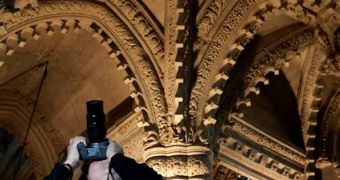"The Da Vinci Code" sparked the imagination of many "conspiracy theory" adepts and raised some questions even in the minds of the pragmatics, since its depiction in the Hollywood production.
Now, researchers claim that they uncovered an encoded message in the cube carvings on the chapel arches of a cathedral in Scotland.
The 15th-century chapel, 10 miles (16 kilometers) from Edinburgh, was built by Sir Gilbert Haye and Sir William Sinclair and is steeped in the traditions of the Knights Templar and Freemasonry.
Stuart Mitchell, 41, a music teacher from Edinburgh and his father, Thomas, say they deciphered a musical code hidden into stone cubes on the ribs supporting the ceiling of Rosslyn Chapel in the village of Roslin, near Edinburgh.
It sounds like a plot from the famous movie, but they say they were able to decipher, after careful analysis of the pattern in which are arranged the small cubes, a musical piece that has been hidden for 500 years in the intricate carvings at the church.
"Breaking the code was a true eureka moment. It's like we have been given a compact disc from the past," said Stuart Mitchell, 41, a music teacher from Edinburgh. "But unlike the fiction of 'The Da Vinci Code,' this is a tangible link to the past."
It took them quite some time to crack the code, but they finally did it and the result was a musical piece that they recorded and which will get its official premiere in the chapel, May 18.
Other musical experts were skeptic, but they couldn't dismiss the Mitchells' theory.
"We have 213 cubes [at Rosslyn], and the possibility that they have something to say is by no means implausible," said Warwick Edwards, an expert on early Scottish music at Glasgow University, who thinks that more research is needed though, to find out how and why the music was so intricately hidden in the walls.
The decoding applications were centered on the ribs of the ceiling in the Lady Chapel, where rows of carved angels play instruments above the columns of cubes.
"Many of the angels had musical instruments and some were arranged as a choir, but there was one angel we couldn't work out," said Thomas Mitchell, 75, a former encryption analyst for the Royal Air Force during the Korean War. "Then we realized she was carrying a musical stave, the lined blueprint for musical composition, and therefore we were looking at a coded piece of music."
If the two are right about the hidden musical message, it could mean that the people who built Rosslyn Chapel between 1446 and 1486 possessed vast knowledge of the science of sound; that was not available in Western Europe until around 1700, so their understanding and interpreting of acoustics was more that two hundred years ahead of their time.

 14 DAY TRIAL //
14 DAY TRIAL //